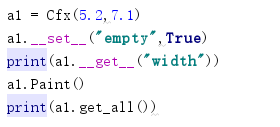[18/11]Python類的
阿新 • • 發佈:2018-12-20
這週上課又學回到了Python面向物件程式設計以及類的封裝等,這裡寫個關於類的應用, 也不是很難,不過相對於基礎來說以及夠夠了。
寫一個類,通過這個工具類能夠畫一個長方形(用*畫)工具類: 長方形類: 屬性: 寬 private double width 高 private double height 面積private double area 周長private double perimeter 是不是空心 private boolean empty 方法: 通過邊長計算面積 通過邊長計算周長 獲取一個長方形:寬度、高度、面積、周長、是否空心的方法(get方法) 修改一個長方形:寬度、高度、是否空心的方法(set方法) 繪製圖形方法:通過屬性判斷是否空心,然後進行圖形繪製
首先定義一個類,名稱就簡單明瞭地用長方形的縮寫好了。
import math
Class Cfx():
要求裡對屬性的型別有要求,定義下屬性,之後建立構造器,給屬性賦初值。
Class Cfx():
__width = 0.0
__height = 0.0
__area = 0.0
__perimeter = 0.0
__empty = True
def __init__(self,width,height):
self.__width = width
self.__height = height
接下來是方法的建立,第一個方法要求計算長方形的面積,根據面積的定義可知area=width*height
def Area(self):
self.__area = self.__width*self.__height
return self.__area
第二個方法是求長方形的周長,定義可知perimeter=(width+height)*2
def Perimeter(self):
self.__perimeter = self.__width*2+self.__height*2
return self.__perimeter
第三個方法是獲取長方形的屬性,這裡我通過屬性值的配對來返回相對應的結果。要注意輸出時都要轉成string型,否則會報錯。
def __get__(self,key): if key =="width": return "寬度:" + str(self.__width) if key =="height": return "\n高度:"+str(self.__height) if key == "area": return "\n面積:"+str(self.Area()) if key =="perimeter": return "\n周長:"+str(self.Perimeter()) if key =="empty": return "\n是否空心:"+str(self.__empty)
如果要返回所有屬性,則用get_all方法。
def get_all(self):
return "寬度:" + str(self.__width)+"\n高度:"+str(self.__height)+"\n面積:"+str(self.Area())+ "\n周長:"+str(self.Perimeter())+"\n是否空心:"+str(self.__empty)
第四個方法是改變相應屬性的值,這裡也是通過屬性名的配對來修改。
def __set__(self,key,value):
if key == "width":
self.__width = value
if key == "height":
self.__height = value
if key == "empty":
self.__empty = value
第五個方法是畫出長方形,這裡首先要注意長方形的長寬可能是小數,然後要判斷是不是空心。 對於帶小數的長方形,我考慮的是將一個*代表的大小改變來畫圖。
def Paint(self):
w = self.__width
h = self.__height
tempw = w - math.floor(w)
temph = h - math.floor(h)
if temph > 0 or tempw > 0:#小數部分
index = 0
while tempw * (10 ** index) < 1: #迴圈直到小數部分大於1為之,最終的index決定一個*代表的大小。
wi = index
index += 1
while temph * (10 ** index) < 1:
hi = index
index += 1
if wi >= hi: #比較長寬哪個的小數更小,選擇小的來作為*所代表的大小
whi = wi
else:
whi = hi
standard = 10 ** (-whi)
print("每個*號代表單位長度%f" % standard) #圖注
w = w * (10 ** whi)
h = h * (10 ** whi)
之後是判斷是否空心以及畫圖,這裡邏輯比較簡單,就不詳細解釋了。
if self.__empty == True:
i = 1
while i<=h:
if i > 1 and i < h:
j = 1
while j <= w:
if j == 1 or j==w:
print("*", end="")
if j>1 and j<w:
print(end=" ")
j += 1
print()
if i == 1 or i == h:
j = 1
while j <= w:
print("*", end="")
j += 1
print()
i += 1
else:
i = 1
while i<=h:
j = 1
while j<=w:
print("*",end="")
j += 1
i += 1
print()
最後是對這個類的測試,測試資料如下:


 圖太長了放不下,不過沒什麼問題。
圖太長了放不下,不過沒什麼問題。
